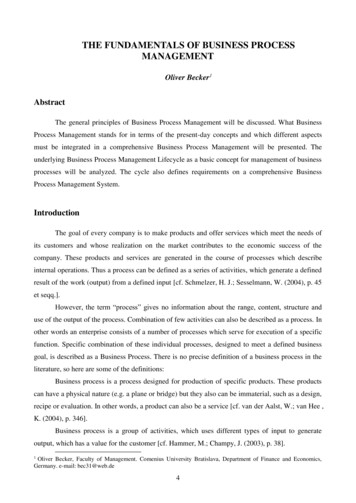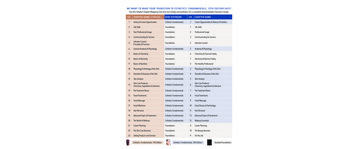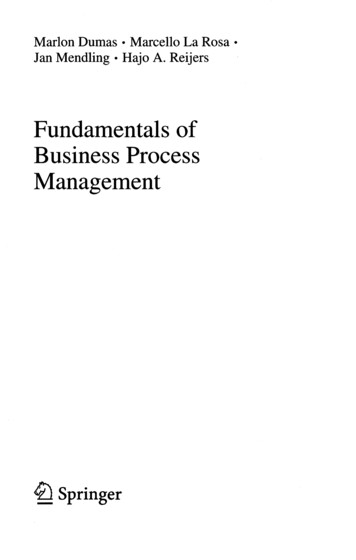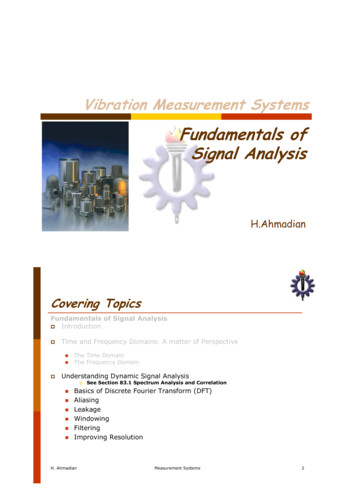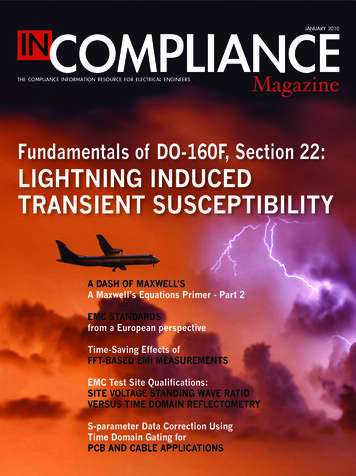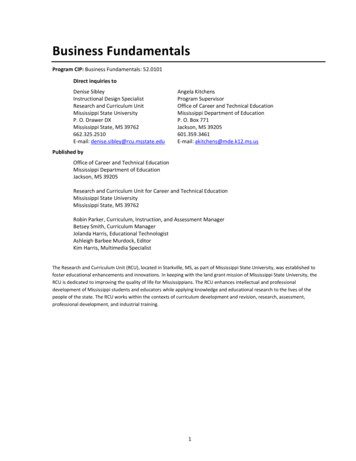
Transcription
Business FundamentalsProgram CIP: Business Fundamentals: 52.0101Direct inquiries toDenise SibleyInstructional Design SpecialistResearch and Curriculum UnitMississippi State UniversityP. O. Drawer DXMississippi State, MS 39762662.325.2510E-mail: denise.sibley@rcu.msstate.eduAngela KitchensProgram SupervisorOffice of Career and Technical EducationMississippi Department of EducationP. O. Box 771Jackson, MS 39205601.359.3461E-mail: akitchens@mde.k12.ms.usPublished byOffice of Career and Technical EducationMississippi Department of EducationJackson, MS 39205Research and Curriculum Unit for Career and Technical EducationMississippi State UniversityMississippi State, MS 39762Robin Parker, Curriculum, Instruction, and Assessment ManagerBetsey Smith, Curriculum ManagerJolanda Harris, Educational TechnologistAshleigh Barbee Murdock, EditorKim Harris, Multimedia SpecialistThe Research and Curriculum Unit (RCU), located in Starkville, MS, as part of Mississippi State University, was established tofoster educational enhancements and innovations. In keeping with the land grant mission of Mississippi State University, theRCU is dedicated to improving the quality of life for Mississippians. The RCU enhances intellectual and professionaldevelopment of Mississippi students and educators while applying knowledge and educational research to the lives of thepeople of the state. The RCU works within the contexts of curriculum development and revision, research, assessment,professional development, and industrial training.1
Table of ContentsAcknowledgments . 3Standards . 5Preface. 6Executive Summary . 7Business Fundamentals Research Synopsis . 10Blueprint . 12Professional Organizations . 13Using This Document . 14Business Fundamentals . 15Unit 1: Introduction to Business . 15Unit 2: Communication and Interpersonal Skills . 21Unit 3: Professional Development . 27Unit 4: Economics . 33Unit 5: Business, Management, and Entrepreneurship . 41Unit 6: Business Law . 47Unit 7: Personal Finance. 52Appendix A: Suggested Rubrics and Checklist . 64Appendix B: 21st Century Skills Standards . 90Appendix C: Mississippi Academic Standards. 91Appendix D: ACT College Readiness Standards . 92Appendix E: National Industry Standards . 105Appendix F: National Educational Technology Standards for Students . 1082
AcknowledgmentsThe Marketing and Economics Curriculum Framework and Supporting Materials was presented to the MississippiBoard of Education on May 15, 2008. The following persons were serving on the state board at this time:Dr. Hank M. Bounds, Executive SecretaryMr. Claude Hartley, ChairMr. William Harold Jones, Vice ChairMr. Howell “Hal” N. GageDr. O. Wayne GannMs. Rebecca HarrisMr. Charles McClellandMs. Sondra Parker CaillavetMs. Rosetta RichardsDr. David SistrunkMike Mulvihill, Interim Associate State Superintendent of Education for the Office of Career and TechnicalEducation, at the Mississippi Department of Education assembled an oversight committee to provide inputthroughout the development of the Marketing and Economics Curriculum Framework and Supporting Materials.Members of this task force were as follows:Dr. Kay Berry – Simpson County School DistrictDr. Sam Bounds – Mississippi Association of School SuperintendentsBeverly Brahan – Mississippi Association of EducatorsDavid Campbell – Mississippi Association of Middle Level EducatorsTommye Dale Favre – Mississippi Department of Employment SecurityMary Hardy – Mississippi PTADr. Anna Hurt – Mississippi Association of School AdministratorsJay Moon – Mississippi Manufacturers AssociationDr. Dean Norman – Center for Advanced Vehicular Systems ExtensionMichael Ray – Western Line School DistrictGeorge Schloegal – Hancock BankCharlene Sproles – Mississippi School Counselor AssociationMike Thomas – North American Coal CorporationPete Walley – Institutions of Higher LearningClarence Ward – Boys and Girls Clubs of the Gulf CoastDr. Debra West – State Board for Community/Junior CollegesThe members of the Marketing and Economics Curriculum Framework and Supporting Materials ProfessionalAdvisory Team were a vital part of the curriculum. Members of this team include the following:Sheila Bowden, White LilyAimee Brown, Newton Career CenterDebbie Burnham, Forest-Scott County Vo-Tech CenterLynn Collier, Itawamba Community CollegeRochelle Dahmer, Forrest County Public SchoolsDr. Diane Fisher, University of Southern MississippiDr. Renee Gammill, Research and Curriculum UnitDenise Hanebuth, Mississippi Department of EducationSuzanne Johnson, Copiah-Lincoln Community CollegeTeresa Jones, Mississippi Department of Education3
Jennifer Koon, Prentiss County Vocational CenterDr. Nicole Lueg, Mississippi State UniversityStephanie McCullough, Gulfport Public SchoolsDanny Mitchell, Godwin MarketingEmily Montgomery, Hinds Community CollegeDr. Brian J. Reithel, University of MississippiRobin Silas, Mississippi Department of EducationDr. Pam Smith, Mississippi Council on Economic EducationPam Stuart, Clinton Public SchoolsMelinda Young, Millsaps Career and Technology CenterGail Litchliter, Mississippi ITSWalt Littleton, Ross Collins Career and Technical CenterSam Puckett, The Ad AgencyAlso, a special thanks is extended to the teachers who contributed teaching and assessment materials that areincluded in the framework and supporting materials. Members who contributed are as follows:Tammie Brewer, Hinds Community College, Rankin, MSNelda Davidson, Ross Collins Career and Technical Center, Meridian, MSAngie Davis, Tupelo High School, Tupelo, MSKathy Dawkins, Millsaps Career and Technology Center, Starkville, MSHeather Burch, Northwest Rankin High School, Brandon, MSAppreciation is also expressed to the following staff members at the Mississippi Department of Education whoprovided guidance and insight throughout the development process:Denise Hanebuth, Program Coordinator, Office of Career and Technical Education, Mississippi Departmentof Education, Jackson, MSChris Wall, Director of Instructional Programs and Student Organizations, Office of Career and TechnicalEducation, Mississippi Department of Education, Jackson, MSGratitude is expressed to the members of the Technology Advisory Committee. This committee played aninstrumental role in the development of the Marketing and Economics Curriculum Framework and SupportingMaterials Laboratory Specifications. Members of this committee were as follows:Dr. Doug Belk, Technology Coordinator, Pascagoula School DistrictMr. Mike Mulvihill, Bureau Director, Office of Career and Technical EducationMs. Christy Todd, Education Specialist, Office of Career and Technical Education4
StandardsStandards in the Business Fundamentals Curriculum Framework and Supporting Materials are based on thefollowing:Academic StandardsMississippi Department of Education Subject Area Testing ProgramACT College Readiness StandardsThe College Readiness Standards are sets of statements intended to helpstudents understand what is expected of them in preparation for the ACT. Thesestandards are integrated into teaching and assessment strategies throughout thecurriculum framework.21st Century Skills and Information and Communication Technologies LiteracyStandardsIn defining 21st century learning, the Partnership for 21st Century Skills has embraced five contentand skill areas that represent the essential knowledge for the 21st century: Global awareness; civicengagement; financial, economic, and business literacy; learning skills that encompass problemsolving, critical-thinking, and self-directional skills; and Information and Communication Technology(ICT) Literacy. Reprinted with permissionNational Educational Technology Standards for StudentsReprinted with permission from National Educational Technology Standards for Students: ConnectingCurriculum and Technology, copyright 2007, ISTE (International Society for Technology inEducation), 1-800-336-5191 (U.S. and Canada) or 1-541-302-3777 (International), iste@iste.org,www.iste.org. All rights reserved. Permission does not constitute an endorsement by ISTE.National MBA Research StandardsReprinted with permission. 2008, MarkED/Career Paths. Columbus, OH, www.Mark-ED.org5
PrefaceSecondary career–technical education programs in Mississippi are faced with many challenges resulting fromsweeping educational reforms at the national and state levels. Schools and teachers are increasingly being heldaccountable for providing true learning activities to every student in the classroom. This accountability is measuredthrough increased requirements for mastery and attainment of competency as documented through bothformative and summative assessments.The courses in this document reflect the statutory requirements as found in Section 37-3-49, Mississippi Code of1972, as amended (Section 37-3-46). In addition, this curriculum reflects guidelines imposed by federal and statemandates (Laws, 1988, ch. 487, §14; Laws, 1991, ch. 423, §1; Laws, 1992, ch. 519, §4 eff. from and after July 1,1992; Carl D. Perkins Vocational Education Act IV, 2007; and No Child Left Behind Act of 2001).6
Executive SummaryProgram DescriptionBusiness Fundamentals serves as the foundation for all Business Pathways. Courses in Business Fundamentalsprovide instruction in basic business skills and knowledge related to economic fundamentals, management,communications, finance, human relations, career development, ethics, and business etiquette.Industry CertificationsThis document was developed according to national standards for business education, as prepared by the Nationalthe National Educational Technology Standards for Students (NETS), 2000–02, developed by the InternationalSociety for Technology in Education (ISTE); and the SCANS Competencies published by the U.S. Department ofLabor, 1992.AssessmentStudents will be assessed using the Business Fundamentals MS-CPAS2 assessment. Districts that elect toimplement Option 1 will administer the exam to students who are completing Business Fundamentals (CourseCode: 992300). Districts that elect to implement Option 2 will administer the exam to students who havecompleted Management Business Fundamentals I (Course Code: 992301) and will be completing BusinessFundamentals II (Course Code: 992302) at the time the MS-CPAS2 is administered.Student PrerequisitesIn order for students to be able to experience success in the Secondary Business Cluster programs, the followingstudent prerequisites are in place:1.2.3.C or higher in English (the previous year)C or higher in Pre-AlgebraInstructor approval1.orTABE Reading Score (Eighth grade or higher)1.orInstructor approvalApplied Academic CreditPersonal Finance content from the curriculum was aligned to the 2004 Mississippi Personal Finance FrameworkRevised Academic Benchmarks. Upon the completion of this program, students will earn 1/2 Personal Financecredit that can be used for graduation requirements. The curriculum framework includes economics contentaligned to the 2004 Mississippi Economics Framework Revised Academic Benchmarks. Upon completion of thisprogram, students will earn 1/2 Economics credit to meet graduation requirements.Licensure RequirementsPlease refer to the licensure requirements found in the curriculum for each Business Pathway.7
Professional LearningIf you have specific questions about the content of each training session provided, please contact the Research andCurriculum Unit at 662.325.2510, and ask for the Professional Learning Department.Options for DeliveryThis Business Cluster curriculum framework provides multiple options for local school districts to implement basedon the local needs of industry and students. For flexibility, the content can be taught in either 1 or 2 Carnegieunits.Option 1 – Two Two-Carnegie-UnitsCourse Description: Business FundamentalsThis year long course begins with an introduction to business and marketing fundaments, communication andinterpersonal skills, and professional development for continued education, training, and careers in businessmanagement. Major topics of study in this course are economics, business, management, and entrepreneurship,business law, and personal finance. Participation in DECA (student organization) is ongoing. Students will developskills toward meeting requirements for the Microsoft Project Skill Standards for Microsoft Office SpecialistCertification.Business Fundamentals (2 Carnegie Units)Course Code: 992300Unit1234567TitleIntroduction to BusinessCommunication and Interpersonal SkillsProfessional DevelopmentEconomicsBusiness, Management, and EntrepreneurshipBusiness LawPersonal FinanceTotalHours10201570553030230Option 2 – Two 1-Carnegie-Unit CoursesCourse Description: Business Fundamentals IThis course begins with an introduction to business and marketing fundaments, communication and interpersonalskills, and professional development for continued education, training, and careers in business management.Major topics of study in this course are business and economics. Participation in DECA (student organization) isongoing. Students will develop skills toward meeting requirements for the Microsoft Project Skill Standards forMicrosoft Office Specialist Certification.Course Description: Business Fundamentals IIThis course begins with an introduction to business and marketing fundaments. Major topics in this course includeeconomics, business, management, entrepreneurship, business law, and personal finance. Participation in DECA(student organization) is ongoing. Students will develop skills toward meeting requirements for the Microsoft8
Project Skill Standards for Microsoft Office Specialist Certification. This option consists of two courses that shouldbe completed in the following sequence:Business Fundamentals I (1 Carnegie Unit)Course Code: 992301Unit1234TitleIntroduction to BusinessCommunication and Interpersonal SkillsProfessional DevelopmentEconomicsTotalHours10201570115Business Fundamentals II (1 Carnegie Unit)Course Code: 992302Unit567TitleBusiness, Management, and EntrepreneurshipBusiness LawPersonal FinanceTotal9Hours553030115
Business Fundamentals Research SynopsisIntroductionThe Business Education Career Cluster covers the field of occupations related to the management of businessoperations, finance, and information. There were over 62 million jobs in the business field in 2010. However,individuals completing programs in business education are employed in almost all economic sectors; therefore, jobprospects will be good for most completers. The industry is projected to have above average growth, 14% in theUnited States and 17% in Mississippi, between 2010 and OpeningsChange 2006–2016NumberPercentMean annual wage(in dollars)Regional Total434,158506,917169,49472,75917% 14.01National Total62,088,21670,965,34622,034,5818,877,13014% 18.62Source: EMSI Complete Employment - 3rd Quarter 2010Needs of the Future WorkforceBusiness, Management, and AdministrationBusiness, management, and administration professionals plan, direct, maintain, and organize business operationsfor an organization. Business and administration managers are employed in all economic sectors. Businessmanagers’ and administrators’ responsibilities vary based on their economic sector and the needs of theiremployers (US Bureau of Labor Statistics, 2009).Business, Management, and Administration Employment Projections and EarningsIn 2010, business managers and administrators held over 5 million jobs in the United States. Their employment iswidespread throughout every industry in the nation. The Business, Management, and Administration field isprojected to grow 16% in Mississippi and 15% in the United States (EMSI, 2010) over the next decade. Jobprospects will be best for those with a degree, industry certifications, and job experience (Bureau of LaborStatistics, 9OpeningsChange 2006–2016NumberPercentMean annual wage(in dollars)Regional Total33,00438,23813,0775,23416% 23.67National Total5,093,7585,881,3181,948,188787,56015% 30.25Source: EMSI Complete Employment ‐ 3rd Quarter 2010MarketingThe Marketing Pathway provides instruction in marketing skills and related sales operations in retailing, as well as70 hr of applied economics instruction. Courses in the program provide a foundation of skills and knowledgerelated to basic principles of marketing and related economic fundamentals, management, merchandising,communications and career development, human relations, ethics, and etiquette.10
Marketing Employment Projections and EarningsOver 1 million workers in the United States were employed in the marketing and economics sector in 2010. Therewill be better than average employment growth in the United States between 2010 and 2019. However, inMississippi the growth will be well above average 16% between 2010 and 2019 (EMSI, 2010). Job prospects will begood for those with formal education, but many will face keen competition in more desirable regions and sectors(US Bureau of Labor Statistics, 9OpeningsChange 2006–2016NumberPercentMean annual wage(in dollars)Regional Total6,8497,9712,6541,12216% 16.67National Total1,462,6861,630,904524,050168,21812% 24.55Source: EMSI Complete Employment ‐ 3rd Quarter 2010Finance and AccountingThe Finance and Accounting Pathway is designed to introduce students into the field of financial analysis andmanagement. Students in the Finance and Accounting Pathway will acquire knowledge and develop skills throughclassroom learning and hands‐on experiences. Nearly every organization has a financial manager or an accountantemployed. They oversee investment strategies, maintain budgets, prepare financial reports and statements, andhelp implement long‐term financial goals for their organizations (US Bureau of Labor Statistics, 2009). In this field,firms are not only seeking individuals with advanced degrees, but they also want future employees that have pastwork experience.Finance and Accounting Employment Projections and EarningsFinancial analysts are among the fastest growing occupations in Mississippi. The occupation is projected togrow 46% in the next decade, which is faster than any other occupation in the pathway. Occupations withinthe Finance and Accounting Pathway are expected to have above average growth in the United States, 22%and in Mississippi, 21 % (EMSI, 2010). Job prospects will be best for those with job experience and advanceddegrees as firms are increasingly employing individuals with graduate degrees or higher (US Bureau of LaborStatistics, 9OpeningsRegional Total45,79855,45816,0679,66021% 14.96National Total7,264,9788,840,9622,663,8491,575,98422% 21.13Source: EMSI Complete Employment ‐ 3rd Quarter 201011Change 2006–2016NumberPercentMean annual wage(in dollars)
BlueprintYou will find the blueprint that corresponds to this document asp?p /Curricula/Career Pathways/.12
Professional OrganizationsAssociation for Supervision and Curriculum Development - ASCD1703 North Beauregard StreetAlexandria, VA on for Career and Technical Education - ACTE1410 King StreetAlexandria, VA ppi Association for Career and Technical Education – MSACTEhttp://www.mississippiacte.com/Marketing Education Association – MEAP.O. Box 27473Tempe, AZ 85285-7473http://nationalmea.org/Mississippi Association of Marketing Educators – MAMEMississippi Association for Supervision and Curriculum Development - MASCDP.O. Box 13576Jackson, MS 39236601.591.2210http://www.mascd.comMississippi Department of Education – MDEOffice of Career and Technical EducationP.O. Box 771Jackson, MS al/news/13
Using This DocumentEach secondary career-technical course consists of a series of instructional units that focuses on a common theme.All units have been written using a common format that includes the following components:Unit Number and TitleSuggested Time on TaskAn estimated number of clock hours of instruction that should be required to teach the competencies andobjectives of the unit. A minimum of 140 hours of instruction is required for each Carnegie unit credit. Thecurriculum framework should account for approximately 75 to 80% of the time in the course.Competencies and Suggested ObjectivesA competency represents a general concept or performance that students are expected to master as arequirement for satisfactorily completing a unit. Students will be expected to receive instruction on allcompetencies. The suggested objectives represent the enabling and supporting knowledge and performancesthat will indicate mastery of the competency at the course level.Suggested Teaching StrategiesThis section of each unit indicates research-based strategies that can be used to enable students to mastereach competency. Emphasis has been placed on strategies that reflect active learning methodologies.Teachers should feel free to modify or enhance these suggestions based on needs of their students andresources available in order to provide optimum learning experiences for their students.Suggested Assessment StrategiesThis section indicates research-based strategies that can be used to measure student mastery. Examples ofsuggested strategies could include rubrics, class participation, reflection, and journaling. Again, teachersshould feel free to modify or enhance these suggested assessment strategies based on local needs andresources.Integrated Academic Topics, 21st Century Skills and Information and Communication Technology LiteracyStandards, ACT College Readiness Standards, and Technology Standards for StudentsThis section identifies related academic topics as required in the Subject Area Assessment Program (SATP) inAlgebra I, Biology I, English II, and U. S. History from 1877, which are integrated into the content of the unit.Researched-based teaching strategies also incorporate ACT College Readiness standards. It also identifies the21st Century Skills and Information and Communication Technology Literacy skills. In addition, nationaltechnology standards for students are associated with the competencies and suggested objectives for the unitare also identified.ReferencesA list of suggested references is provided for each unit. The list includes some of the primary instructionalresources that may be used to teach the competencies and suggested objectives. Again, these resources aresuggested, and the list may be modified or enhanced based on needs and abilities of students and on availableresources.14
Business FundamentalsUnit 1: Introduction to BusinessCompetency 1: Identify school and program policies and procedures. (DOK1, BC1, BC5)Suggested Enduring Understandings1.2.Rules exist for the safety and benefit ofeveryone.School and program policies, procedures, andexpectations reflect the standards of industry.Suggested PerformanceIndicatorsa.Suggested Essential QuestionsPreview the schoolhandbook and allsafety procedures forthe classroom leveland building level.(DOK1)1.2.What are the rules for the local school, and howdo they benefit students?How do school and program policies, procedures,and expectations mirror those found in industry?Suggested Teaching Strategiesa. Have students analyze various case studies orscenarios that describe various hazardoussituations.Have students brainstorm possible solutions anddiscuss basic first-aid procedures for handlingeach scenario. (E1, E2, E3, E4, E5, E6, R2, R3, R4, R5, R6, W1, W2, W3,W4, W5, S1, M1, CS1, CS2, CS3, CS4, CS5, T1, T2, T3, T4, T5, T6 )Have a guest speaker from the local firedepartment come and discuss fire extinguishersafety and basic first-aid techniques. (E1, E2, E3, E4, E5,E6, R2, R3, R4, R5, R6, W1, W2, W3, W4, W5, CS1, CS2, CS3, CS4, CS5, T1, T2,T3, T4, T5, T6)Suggested AssessmentStrategiesa. Assess studentknowledge ofhazardous situationsusing the Case StudyAssessment Rubric,class participation, andbrainstorming sessionresults.Assess studentknowledge of basicsafety and first-aidprocedures byadministering a safetytest and allowing thestudents to rate thespeaker using theguest speakerevaluation form.Competency 2: Discuss the purpose of the course. (DOK1, BC1, BC4)Suggested Enduring Understandings1. Student and course expectations must be met inorder to receive credit for the course.2. Career and Technical Education StudentOrganizations (CTESOs) are a vital part of ourcurriculum, and they provide opportunities forcareer development.Suggested PerformanceIndicatorsa. Identify student andcourse expectations.Suggested Essential Questions1. What are the student and course expectations?2. How can CTESOs benefit students?Suggested Teaching Strategiesa. Review course units and objectives to be mastered.(DOK1)15Suggested AssessmentStrategiesa. Assess studentunderstanding byobservingcontributions to classdiscussions and
Show students the various textbooks that will beused throughout the teaching of this course. Havethe students complete a scavenger hunt oftextbook items such as “What page does Chapter11 begin on?” and “What is the name of Chapter1?”Pass out course syllabus and grading policy tostudents. Discuss and answer any questions aboutthe handouts.Discuss classroom equipment and log-inprocedures for computers.participation inactivities.Evaluate studentunderstanding of howto use a textbook bygrading the scavengerhunt.Check studentnotebooks forhandouts of syllabusand grading policies.Assess studentknowledge of properequipment usage andproper log-inprocedures byobserving them asthey complete thesetasks.16
b. Explore studentorganizations andtheir roles inindividual careerdevelopment. (DOK1)b. Describe the CTESOs associated with the program,and provide an overview of trips, competitiveevents, leadership activities, and communityservice projects that students will have theopportunity to participate in through this course.b. Administer a writtentest on CTESO ofchoice to assessstudentunderstanding.Have students research and explore the CTESOWeb site and complete a teacher-created questionand-answer, fill-in-the-blank, or Webquest ordevelop a slide presentation, brochure, or displaythat includes but is not limited to the motto, creed,emblem, colors, theme, and history of theorganization. Also, have students research whichfamous or successful people were part of theorganization. ( E1, E2, E3, E4, E5, E6, R2, R3, R4, R5, R6, W1, W2, W3,Assess completedWebquest answers,brochure, slidepresentation, ordisplay using variousrubrics and/orchecklists.Discuss with students the election process used inthe CTESO; compare and contrast this process withthe processes used for local, state, and nationalelections. Emphasize the importance ofparticipating in elections as a part of goodcitizenship. Also, have students participate in localofficer elections modeled after the electionprocess. ( E1, E2, E3, E4, E5, E6, R2, R3, R4, R5, R6, W1, W2, W3, W4, W5,Assess studentunderstanding byobserving s
5 Business, Management, and Entrepreneurship 55 6 Business Law 30 7 Personal Finance 30 Total 230 . Option 2 – Two 1-Carnegie-Unit Courses . Course Description: Business Fundamentals I . This course begins with an introduction to business and marketing fun



